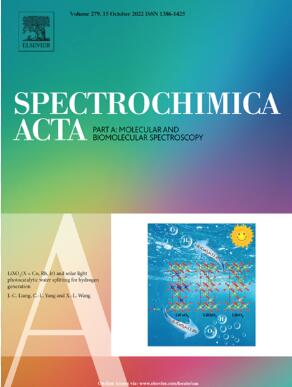Assessing the role of zinc in the structure-stability-activity paradigm of bacteriophage T7 endolysin
IF 4.3
2区 化学
Q1 SPECTROSCOPY
Spectrochimica Acta Part A: Molecular and Biomolecular Spectroscopy
Pub Date : 2025-05-23
DOI:10.1016/j.saa.2025.126466
引用次数: 0
Abstract
Inorganic cofactors, such as zinc, contribute to enzymatic reactions, protein folding, and enzyme stability. T7 endolysin or T7 lysozyme (T7L), a zinc-dependent amidase involved in the lysis of bacterial cell walls, has great potential for applications in biotechnology and medicine. The present study provides an in-depth analysis of the structure stability and catalytic features of T7L, focusing on the comparison of its Apo and Holo forms using turbidimetric assay, circular dichroism, fluorescence spectroscopy, nuclear magnetic resonance (NMR) spectroscopic methods and molecular dynamics simulations. T7L Apo and T7L Holo forms showed moderate structural differences in the secondary structure; hydrophobic exposure was observed at the tertiary level. Chemical denaturation studies indicated higher stability in T7L Holo compared to the Apo form. The pH-dependent NMR analyses implied the protective role of zinc in the Holo form at lower pH levels, down to pH 5. The turbidimetric assay further revealed the affirmative role of zinc as a cofactor for its amidase activity. Molecular dynamics simulation studies further ally with these results, demonstrating the secondary conformational stability of T7L Holo compared to the Apo form. T7L Holo exhibits dynamic interactions with the solvent water, underlining the flexible arrangements of bonds that drive the enhanced catalytic function of T7L Holo. These results provide insights into protein enzymology, emphasizing the crucial influence of cofactors on enzymatic reactions and protein stability. The distinct features of structure-stability-activity between Apo and Holo forms of T7L under various conditions pave the way for the development of strategies based on T7 endolysin to combat microbial resistance.
评估锌在噬菌体T7内溶素结构-稳定性-活性范式中的作用
无机辅因子,如锌,有助于酶的反应,蛋白质折叠和酶的稳定性。T7内溶素或T7溶菌酶(T7L)是一种参与细菌细胞壁裂解的锌依赖性氨基酶,在生物技术和医学领域具有巨大的应用潜力。本研究深入分析了T7L的结构稳定性和催化特性,重点使用比浊法、圆二色性、荧光光谱、核磁共振(NMR)光谱方法和分子动力学模拟对其Apo和Holo形态进行了比较。T7L Apo型和T7L Holo型在二级结构上表现出适度的结构差异;在三级水平观察到疏水暴露。化学变性研究表明,与载脂蛋白形式相比,T7L Holo的稳定性更高。pH依赖的核磁共振分析表明,在较低的pH水平下,低至pH 5,锌在Holo形式中的保护作用。浊度测定进一步揭示了锌作为辅助因子对其酶活性的肯定作用。分子动力学模拟研究与这些结果进一步一致,证明了T7L Holo与Apo形式相比的二级构象稳定性。T7L Holo表现出与溶剂水的动态相互作用,强调了驱动T7L Holo增强催化功能的键的灵活排列。这些结果为蛋白质酶学提供了新的见解,强调了辅因子对酶反应和蛋白质稳定性的重要影响。不同条件下Apo型和Holo型T7L在结构-稳定性-活性上的不同特征,为开发基于T7内溶素的抗微生物耐药策略铺平了道路。
本文章由计算机程序翻译,如有差异,请以英文原文为准。
求助全文
约1分钟内获得全文
求助全文
来源期刊
CiteScore
8.40
自引率
11.40%
发文量
1364
审稿时长
40 days
期刊介绍:
Spectrochimica Acta, Part A: Molecular and Biomolecular Spectroscopy (SAA) is an interdisciplinary journal which spans from basic to applied aspects of optical spectroscopy in chemistry, medicine, biology, and materials science.
The journal publishes original scientific papers that feature high-quality spectroscopic data and analysis. From the broad range of optical spectroscopies, the emphasis is on electronic, vibrational or rotational spectra of molecules, rather than on spectroscopy based on magnetic moments.
Criteria for publication in SAA are novelty, uniqueness, and outstanding quality. Routine applications of spectroscopic techniques and computational methods are not appropriate.
Topics of particular interest of Spectrochimica Acta Part A include, but are not limited to:
Spectroscopy and dynamics of bioanalytical, biomedical, environmental, and atmospheric sciences,
Novel experimental techniques or instrumentation for molecular spectroscopy,
Novel theoretical and computational methods,
Novel applications in photochemistry and photobiology,
Novel interpretational approaches as well as advances in data analysis based on electronic or vibrational spectroscopy.

 求助内容:
求助内容: 应助结果提醒方式:
应助结果提醒方式:


